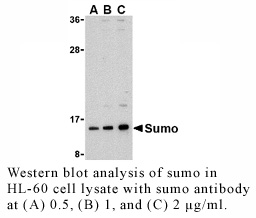Anti-Human Sumo
Data
- -
- -
Antibody DetailsProduct DetailsReactive Species Human Host Species Rabbit Immunogen PN:S532 Product Concentration 0.5 mg/ml Formulation This polyclonal antibody is formulated in phosphate buffered saline (PBS) pH 7.4 containing 0.02% sodium azide as a preservative. Storage and Handling This polyclonal antibody is stable for at least one week when stored at 2-8°C. For long term storage, aliquot in working volumes without diluting and store at –20°C in a manual defrost freezer. Avoid Repeated Freeze Thaw Cycles. Country of Origin USA Shipping Next Day Ambient RRIDAB_2831773 Each investigator should determine their own optimal working dilution for specific applications. See directions on lot specific datasheets, as information may periodically change. DescriptionDescriptionSpecificity Rabbit Anti-Human Sumo recognizes Human, Mouse and Rat Sumo. This polyclonal antibody was purified using affinity chromatography. Background The sumo family of proteins is related both structurally and functionally to ubiquitin in that they are post-translationally attached to the e-amino group of a lysine residue of the substrate protein. This sumoylation plays a number of roles in DNA replication and repair, protein targeting to various subnuclear structures, and the regulation of numerous cellular processes including the inflammatory response in mammalian cells. Sumo was initially identified as a covalent modification of RanGAP1 in studies on nuclear import in mammalian cells. More recently, sumo has been shown to be involved in the regulation of transcription factors, possibly by enhancing their interactions with co-repressors. Sumo is also thought to play some role in the modulation of ubiquitin-mediated degradation of proteins by acting as an inhibitor. At least four different isoforms of sumo are known to exist; Sumo antibody will only recognize isoform 1. PubMed References & Citations1. Dohmen, RJ. (2004) Biochim. Biophys. Acta 1695:113 2. Matunis, MJ. et al. (1996) J. Cell Biol. 135:1457 3. Gill, G. (2005) Curr. Opin. Genet. Dev. 15:536 4. Desterro, JM. et al. (1998) Mol. Cell 2:233 Technical ProtocolsCertificate of Analysis |



